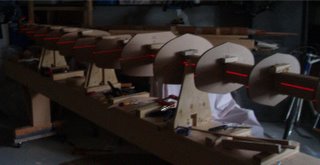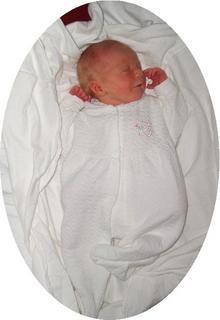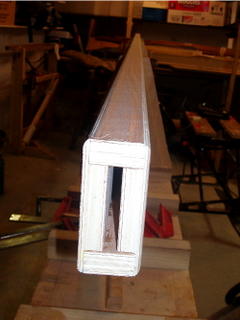 This is my second screw-up so far for those that are counting (well, the second of note anyway). If you look closely at the picture of the stern end form (click on it for a larger version) you might notice that there is a gap of 1/2" between the end of the strongback and the end of slot into which the strongback fits. "Hmmm ... that doesn't look quite right." Last night I realised that I had placed the last form forward of the end form on the aft side of the reference line when it should have been to the forward side of the line. The form is 1/2" thick and therefore, that shifts the end form back by 1/2". See the ruler sitting there - it is 12" and should not fit between the forms, but should be 1/2" too long to fit between. The forms are positioned such that the strips contact the aft edge of the form and thus, it is the aft edge of this form that should have been at the line rather than the forward edge. Oh well, it's easily fixed. Just moving that one form forward 0.5" would have been the simple answer, but it would have meant moving my very carefully aligned form. Instead I chose a different, yet still simple, approach. I tapered the form so that strips would still make contact with the edge of the form that is in the correct position (now the forward edge) and be able to come together at the stern. I then cut 1/2" off of the front edge of the stern end form so that it fit properly where it was supposed to be. The gap disappeared, order was restored to the world. Phwew, good thing I caught that one - who knows what sort of apocalyptic effects it might have had to produce a boat 12.7 mm too long!
This is my second screw-up so far for those that are counting (well, the second of note anyway). If you look closely at the picture of the stern end form (click on it for a larger version) you might notice that there is a gap of 1/2" between the end of the strongback and the end of slot into which the strongback fits. "Hmmm ... that doesn't look quite right." Last night I realised that I had placed the last form forward of the end form on the aft side of the reference line when it should have been to the forward side of the line. The form is 1/2" thick and therefore, that shifts the end form back by 1/2". See the ruler sitting there - it is 12" and should not fit between the forms, but should be 1/2" too long to fit between. The forms are positioned such that the strips contact the aft edge of the form and thus, it is the aft edge of this form that should have been at the line rather than the forward edge. Oh well, it's easily fixed. Just moving that one form forward 0.5" would have been the simple answer, but it would have meant moving my very carefully aligned form. Instead I chose a different, yet still simple, approach. I tapered the form so that strips would still make contact with the edge of the form that is in the correct position (now the forward edge) and be able to come together at the stern. I then cut 1/2" off of the front edge of the stern end form so that it fit properly where it was supposed to be. The gap disappeared, order was restored to the world. Phwew, good thing I caught that one - who knows what sort of apocalyptic effects it might have had to produce a boat 12.7 mm too long![Screw-up #1 occurred a week or two ago while cutting the taper into the boxbeam that holds the forms. The beam must be tapered so that it fits into the narrow ends of the kayak. I cut the one for the bow which went well enough, then I flipped the beam around and thought to myself "better make sure to cut the taper on the correct side because that would be a pretty stupid mistake if I cut them on opposite sides of the beam." And, of course, that's what I promptly did. I realised it before finishing the cut and since the saw has an 1/8" kerf, I filled the gap by gluing in some 1/8" hardboard I had handy. Then I went to bed. After a good sleep and a with a clearer mind, I re-cut the taper properly. You can just barely see the fixed cut in the photo above, but it extends almost all the way through the strongback beam stopping within about 3/4" of the edge.]









